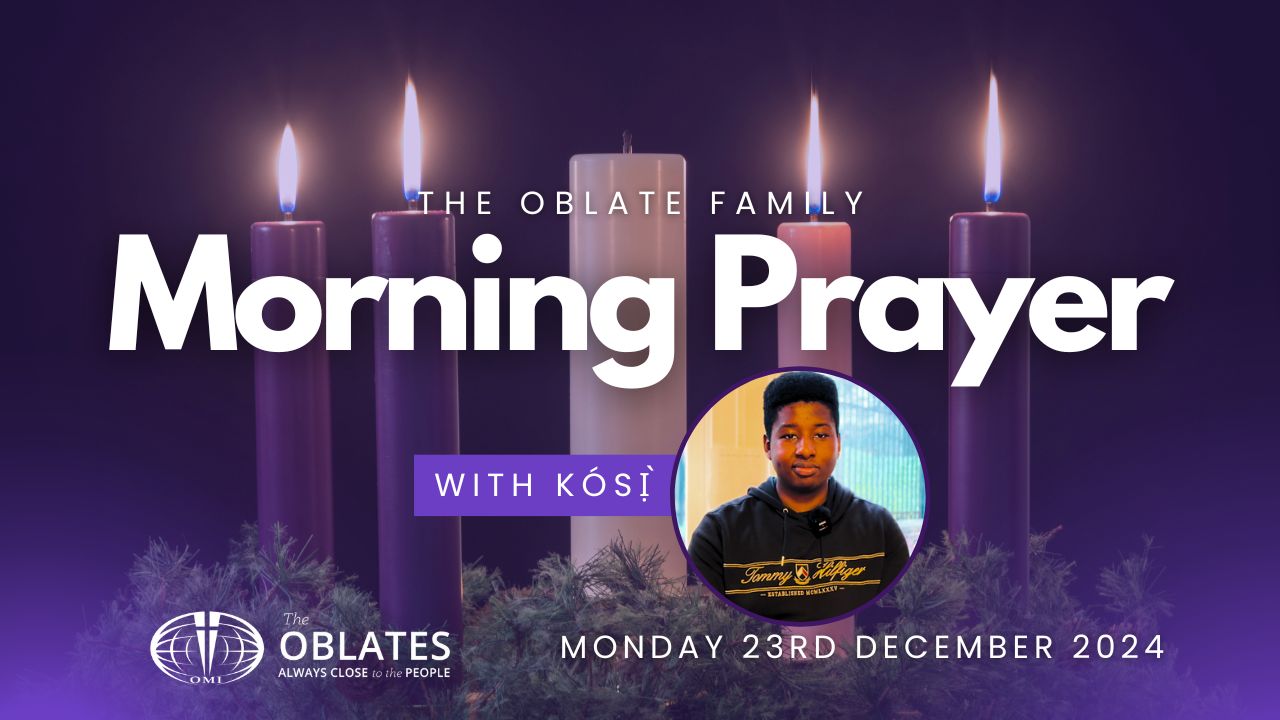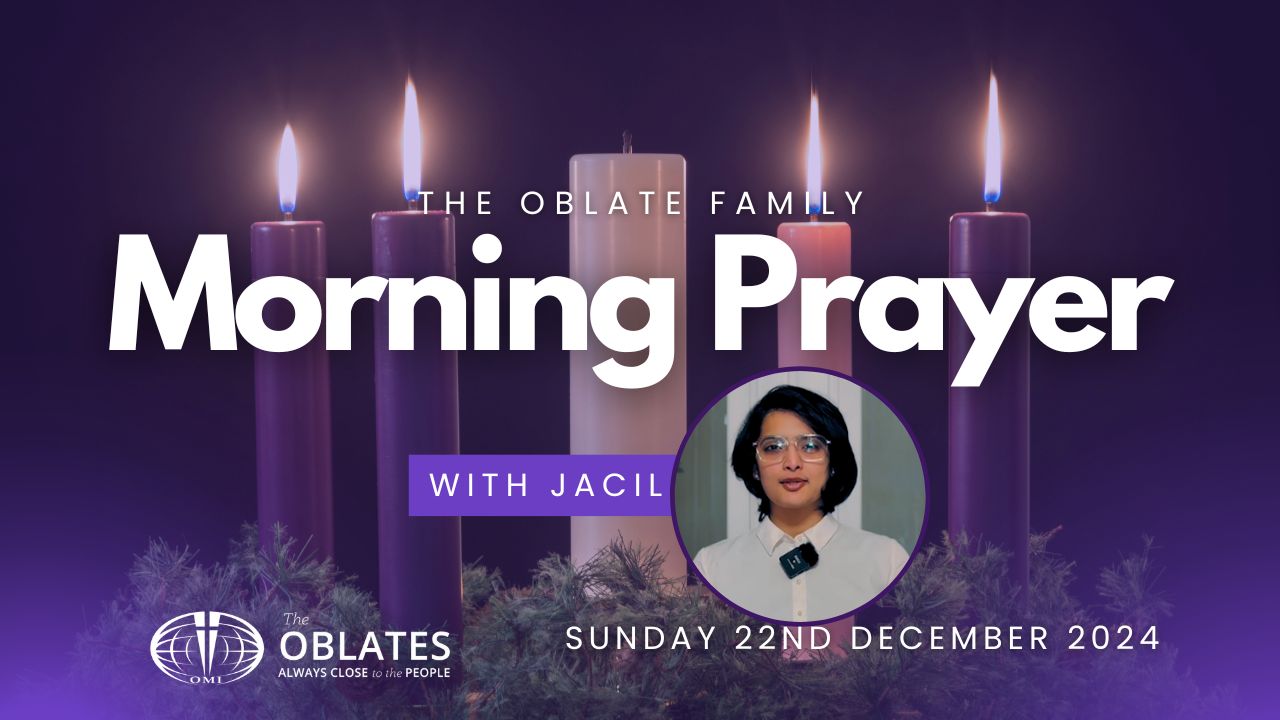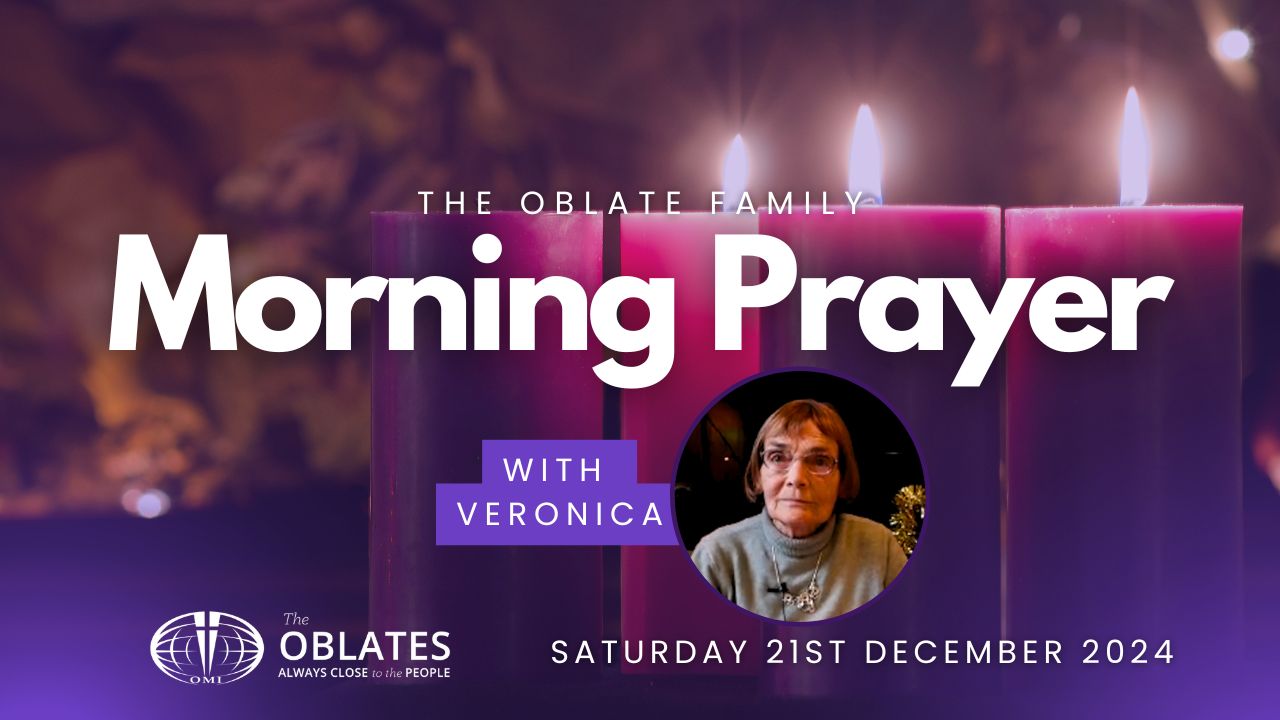Oblate News
Letter of the Superior General on the 197th Anniversary of the Papal Approbation of the Constitutions and Rules

Dear fellow pilgrims, Oblates and members of our charismatic family,
The months of January and February are marked by two important dates for our family: the beginning of the missionary community in Aix on January 25, 1816, and the pontifical approval of our Constitutions and Rules (CCRR) on February 17, ten years later. These days we are holding our first plenary session in which the Central Government and all the directors of the general services have begun to try to put into practice the proposals of our last General Chapter. Listening and reflecting on our origins, I thought about sharing some dreams about our common home, our charismatic family.
In the mind of Saint Eugene, the house in Aix is the place to which we always must return to find our identity. We have all read his memoirs on those first moments of life together in the old Carmel in Aix. For us, Aix is not a museum. If its walls speak to us today, it is because those men knew how to turn that house into a true missionary home. Every time we visit that house, we feel something of our own, something that speaks to us: Aix is our home; Aix lives within us.
Faced with the possibility of opening a new house, the missionaries considered how to live the same spirit, despite the distance. Eugene de Mazenod would write our first Rules, ensuring that each Oblate house maintain what is proper to our family. Successive crises will lead Eugene, urged on by his brothers, to risk traveling to Rome to seek pontifical approval: it was a matter of life or death, of being or not being! Ten years after the beginning of the adventure, the Pope would approve the Rules that from that moment on would become the road map to make all Oblate communities, present and future, a missionary home like the one in Aix.
With the pontifical approval of our Rules, the gift received in Aix becomes both a task for each one who embraces this lifestyle and also a commitment to hand on this heritage to future generations. Our 37th General Chapter calls us to take care of our common home: our Congregation and our charismatic family. Everything that we can propose to animate our charism, by applying the proposals of the Chapter, presupposes strengthening the life and mission of the local communities: it is in the local communities where we live out our present and our future, our identity and mission.
During our discussions in the plenary session, the General Councillor for Africa-Madagascar proposed an image to motivate the post-Chapter animation: the life of a couple. I imagine this couple looking for a house to start their life together. Once they find it, probably more modest than they dreamed, they must prepare it according to their tastes and needs. Talking it over, they must decide many things: what the furniture will be like, the decoration, some remodelling… In addition, they must organize their life together, their way of cooking, how they will make decisions, how they will solve conflicts; but above all, they must take care of their relationships and dream together about the future, about children, etc. Living together and knowing how to overcome difficulties, little by little they will turn the house they live in into their home and the home of their children. A home that, being more than simply a dwelling, will live within them forever. Even if they have to move to a different house, that will still be their home. We all have experienced this.
To take care of our common home, we will have to listen attentively and gratefully to those who live the charism from within the vocation of marriage and family. How much we can learn from them! Do we listen enough? Do we go to “their” school to learn how to make a home out of our common home?
To make our house a missionary home like the one in Aix: a gift and a task
The Founder dreamt of us as the most united family on Earth. In his letters to the Oblates, he insists that, to keep this spirit alive, one must be faithful to the Rules and live together, in community. Practically all the Superiors General agree on this: our charism cannot be lived without this community dimension! The 37th General Chapter also invites us to let ourselves be inspired by our Constitutions and Rules to care for our common home, especially in these years as we prepare to celebrate the 200th anniversary of its pontifical approval.
It is true that looking at our communities, we could focus on our weaknesses, our failures and sins, to try to correct them; indeed, there are things to change in our personal lives, our community, and our family. Some, following this path, fall into the temptation of eternal regret for things that are not going well and become prophets of doom, always pessimistic, but rigid when it comes to proposing alternatives. I would like to follow another path that, for me, is much more urgent: that each member of our family rediscover the beauty of our missionary vocation lived in apostolic communities. Amazed and attracted by the beauty of living our vocation together, we will be able to find new energy to change what does not correspond to the gift received.
Community life is a missionary gift that we must make fruitful by collaborating with the Holy Spirit: that is our task. The CCRR are the gift that the Church gives us to check if we are walking evangelically in the right direction. The Rules are the roadmap to make our communities authentic missionary homes, to make each house an authentic missionary home like the one in Aix. The prayerful reading of our Constitutions and Rules has generated new forms of lay and religious life. I myself am a witness to this, among youth, the laity and even with new modalities of consecrated and missionary life. The Spirit is acting and that is why I dare to dream that the commitment to live the CCRR in a more radical way and within the different charismatic realities will generate a new life for the good of the Mission, of the Church and above all, for the good of the poor and most abandoned.
Communities as prophetic signs
C.91 says: “It is of the nature of a local community to be a prophetic sign that offers grounds for hope to the world in its search for integrity and harmony.” What an amazing statement and what a wonderful challenge! Making our way of living in community a prophecy that gives hope to a world that is falling apart. Renewing our local communities according to the CCRR is a missionary urgency. Everything we propose should answer this question: how to live the apostolic community in order to be prophets of hope and communion?
How I would like each Oblate community to become a home where the poor are listened to, welcomed, protected, recognized in their dignity and helped to become fully human, Christian and holy! Furthermore, how much we will learn from the poor if we allow them to be at the centre of our community and missionary life! A community, like that of Jesus with the Apostles, in which the marginalized and abandoned occupy the centre of the common table, where we share everything we are and have in order to live the Gospel together.
We are called to “to be a leaven of the Beatitudes at the heart of the world,” (C.11) and our local communities, always on the move, must live the Beatitudes together and go out to announce them. We must convert all the paths we trod into an announcement of the Beatitudes of the Kingdom. For Jesus, that was so important that he did not hesitate to give his life, to live his love to the extreme in his own oblation. As missionaries, we must remember that our lifestyle must be in harmony with our Oblate identity and live evangelically: we must choose to cultivate our relationships in an evangelical stance of fraternity, while our houses adopt simple forms that are not counter-testimony to what we preach. That is why it is urgent that each community ensure the protection and safeguarding of the most vulnerable and continue updating the practices and policies that guarantee this protection. This should also be a missionary concern of the first order in all local communities!
Let’s make our houses become missionary homes, centred on Jesus Christ, living the Gospel, welcoming and protecting the most vulnerable and going out as pilgrims of hope in communion.
Remodelling our common home
To make our houses true homes, sometimes we need to remodel them. With the arrival of the children, you must think about how to remodel the house to welcome them, protect them so that they can develop. Even those who live in a nomad or refugee tent should think about expanding their space to adapt to a growing family (Is 54,2-3). On other occasions, houses are remodelled so that the elderly or sick can live and be cared for. Sometimes they are small jobs; others are more complex. If everything is done well, the house, without losing its identity, will be a better home, adapted to the needs of the family. Well then, the General Chapter challenges us to remodel our common home in two directions: the global project of restructuring the Congregation of Oblate religious and the search for adequate structures to make missionary communion grow among the members of our charismatic family, especially with the laity.
The capitular document Pilgrims of Hope in Communion (PHC) speaks to us about the interdependence that is a consequence of the dynamics of communion which evangelical life generates as a response to a common vocation. Interdependence calls for the implementation of concrete actions that seek the common good of the family. These actions must be guided by the principles of solidarity and subsidiarity. Solidarity invites us to share, even what is necessary, to seek the common good. Subsidiarity is the principle by which each level of authority must be respected and helped to fulfil its responsibilities. These two principles can help us live interdependence in a dynamic and just way.
The little or the much that we do affects, for better or for worse, our family as a whole and, at the same time, what others do and experience belongs to us. We must discern what we must do, but let us be aware that passivity, doing nothing, is putting our family in danger. What to do and how to do it together? It is not just a matter of changing external structures; it is above all a call for personal and community conversion. It would be useless to embellish the “house” if those who inhabit it do not set out to improve their relationships in the light of the Gospel. I believe that the first and most important step is taken in our personal lives and in the life of our local community.
C. 29 invites us to “help each other find joy and fulfilment in our community life and in our apostolate.” Here I find that homey warmth that we need: to help each other, in truth and charity, to find fullness of life and joy in our missionary and community vocation. Many times, the first step of our pilgrimage will consist of finding the brother next door to help us mutually live our vocation with joy and thus be able to start the journey together. That short step is sometimes not easy and perhaps seems impossible. Let us trust in Jesus and his Spirit to walk this path that will sometimes require moments of reconciliation and forgiveness.
I am astonished at how categorically C. 91 states: “Every Oblate has the right and duty to belong to a local community and to participate in its life and mission.” Living in a community is a right that everyone must respect and promote at all levels. We must try everything, making courageous decisions, so that each Oblate in vows develops this right and this obligation. The required minimums are found in the Constitutions and Rules, and are, among others: “communities where you pray and reflect on how to live the Gospel in a more radical way; where you grow in fidelity to your vocation; where you live a community project; where there are at least three Oblates living together; and there is a superior who animates and guides” (C.91 – 93). I ask all the members of our charismatic family to help us live these minimums.
Someone will tell me that it is not enough to live under the same roof for the community to be a missionary home. That’s true. For this reason, while we are designing the “general plan of action” called for by the 37th Chapter, with the humility of recognizing that I am the first who must set out, I dare to propose some steps to take together to rediscover the beauty of our vocation and to move forward, caring for our common home to turn it into a missionary home like the one in Aix.
Some proposals for our common pilgrimage:
1. I invite each member of our family to try everything so that those who live the charism in their local community find joy and happiness in their vocation and mission (C.29).
2. I invite all members of the charismatic family to evaluate their lifestyle and the lifestyle of their local community in the light of the CCRR and the Gospel.
3. I invite each local community to elaborate its community and missionary project, in collaboration with other members of the charismatic family. A simple model is suggested by the document of the Chapter “PHC”: pilgrims (Continuing Formation and Constitutions and Rules) of hope (Common Home, Laudato Si and Interdependence) in communion (Restructuring and Laity and Charismatic Family). Other models can be found in the document “Support and discern the Oblate Mission.”
4. That each Mission, Delegation and Province evaluate the community life of its Unit in light of the CCRR (communities with a minimum of three Oblates, with a specific community and missionary project, sharing what one is and has, with a superior and a structure adapted to its context) and implement the changes to the CCRR approved at the 37th General Chapter before the next Intercapitular meeting.
5. That the mandate of the 37th General Chapter in relation to lay associates (PHC, H) and the protection of vulnerable people (PHC, E) be put into practice in the local communities and in the Units.
6. As the Central Government, in addition to the implementation of all of the above at our level, we commit ourselves to implement the mandate of the General Chapter on the remodelling of the Congregation (PHC, K Restructuring) by presenting proposals at the next Intercapitular meeting, to be discerned in the years preceding the 38th General Chapter.
7. As the Central Government, we will support each Unit in animating and living evangelical community according to our CCRR and in remodelling the Units according to their criteria before the next General Chapter. We will also seek, synodally with the laity and other members of the charismatic family, the most appropriate structures for their reality to journey together in our common vocation.
We are already on our way. A journey of faith, hope and charity from which we expect many missionary fruits. If all of us, in a synodal, supportive and subsidiary way, follow the path proposed by the CCRR and the 37th General Chapter, I am convinced that we will find the way to build those missionary homes dreamed of by the Founder and that we will be able to remodel our common home to continue to be the closest family on Earth. Thank you for embarking on the path, thank you for your gift of self.
May Mary Immaculate, who is on pilgrimage with us, teach us to make our homes and our world a home for Jesus and for the poor and most vulnerable.
May Saint Eugene and the Blessed Oblates give us the strength to journey like them, docilely open to the surprises of the Holy Spirit.
May we all find fullness of happiness and joy in our community life and in our mission as pilgrims of hope in communion.
Your pilgrim brother,
Luis Ignacio Rois Alonso, OMI
Superior General
Tags: 37th general chapter, pilgrims of hope in communion, superior general
Recent news
The Oblate Family Morning Prayer: Monday 23rd December 2024

Good morning. We invite you to join Kósị̀ for today’s morning prayer...
The Oblate Family Morning Prayer: Sunday 22nd December 2024

Good morning. We invite you to join Jacil for today’s morning prayer...
The Oblate Family Morning Prayer: Saturday 21st December 2024

Good morning friends. We invite you to join Veronica for today’s morning...

